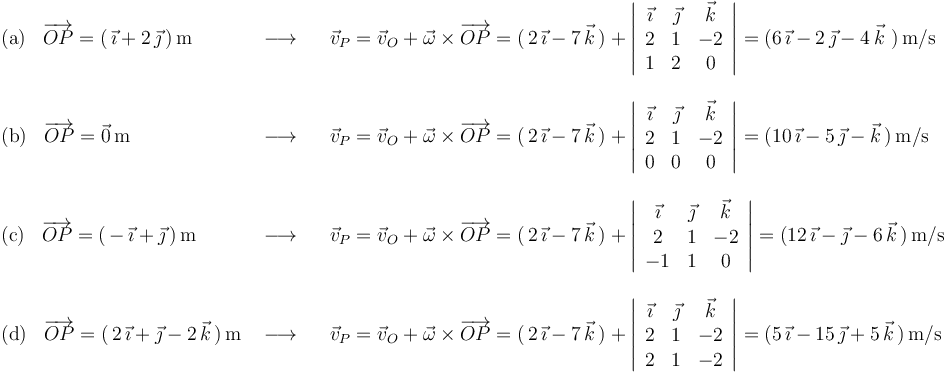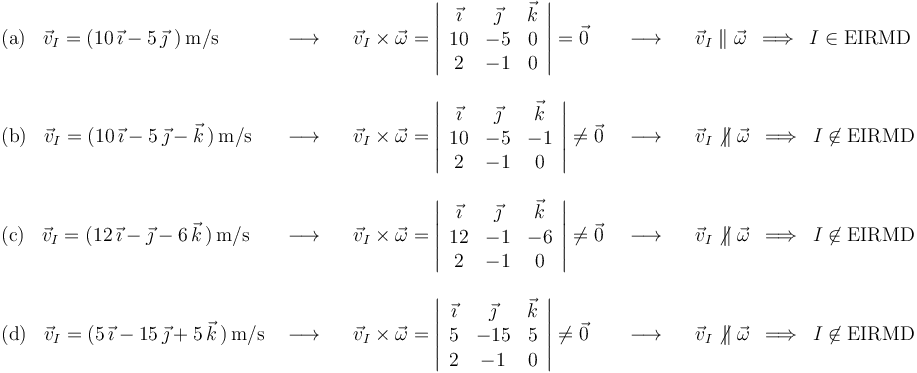No Boletín - Cuestión sobre EIRMD III (Ex.Ene/16)
De Laplace
Contenido |
1 Enunciado
Un sólido rígido realiza un movimiento helicoidal instantáneo respecto a un triedro de referencia  , estando
definido su campo de velocidades mediante la siguiente reducción cinemática en el origen de coordenadas
, estando
definido su campo de velocidades mediante la siguiente reducción cinemática en el origen de coordenadas  :
:

- Calcule la velocidad de deslizamiento del sólido rígido (segundo invariante).
- ¿Por cuál de los siguientes puntos pasa el eje instantáneo de rotación y mínimo deslizamiento?

2 Velocidad de deslizamiento
La velocidad de deslizamiento  (segundo invariante) es la proyección de la velocidad de cualquier punto sobre la velocidad angular:
(segundo invariante) es la proyección de la velocidad de cualquier punto sobre la velocidad angular:

3 Punto perteneciente al EIRMD. Primer método: cálculo de la velocidad del punto 
Utilizando la ecuación del campo de velocidades del sólido rígido, calculamos la velocidad  del punto
del punto  en cada una de las opciones:
en cada una de las opciones:

Si el punto  pertenece al eje instantáneo de rotación y mínimo deslizamiento (EIRMD), la velocidad
pertenece al eje instantáneo de rotación y mínimo deslizamiento (EIRMD), la velocidad  de dicho punto es necesariamente paralela al vector velocidad angular
de dicho punto es necesariamente paralela al vector velocidad angular  . Comprobamos que tal cosa sólo ocurre en la opción (a), la cual es por tanto la respuesta correcta:
. Comprobamos que tal cosa sólo ocurre en la opción (a), la cual es por tanto la respuesta correcta:

4 Punto perteneciente al EIRMD. Segundo método: determinación del EIRMD
Partiendo del conocimiento de la reducción cinemática  , es posible determinar el EIRMD del movimiento helicoidal instantáneo. En efecto: aplicando la ecuación vectorial del EIRMD, obtenemos la posición (relativa a
, es posible determinar el EIRMD del movimiento helicoidal instantáneo. En efecto: aplicando la ecuación vectorial del EIRMD, obtenemos la posición (relativa a  ) de un punto genérico
) de un punto genérico  del EIRMD:
del EIRMD:
![\overrightarrow{AI}=\frac{\vec{\omega}\times\vec{v}_A}{|\,\vec{\omega}\,|^2}\,+\,\lambda\,\vec{\omega}=\frac{1}{5}\left|\begin{array}{ccc} \vec{\imath} & \vec{\jmath} & \vec{k} \\ 2 & -1 & 0 \\ 5 & -15 & 5 \end{array}\right|\,+\,\lambda\,(2\,\vec{\imath}\,-\,\vec{\jmath}\,)=[\,(-1\,+\,2\lambda)\,\vec{\imath}\,-\,(2\,+\,\lambda)\,\vec{\jmath}\,-\,5\,\vec{k}\,]\,\mathrm{m}](/wiki/images/math/3/c/1/3c173065f0457c80dceda3ba4891a65a.png)
Y conocidas las coordenadas del punto  en el triedro OXYZ de referencia, es fácil determinar las coordenadas en dicho triedro de un punto genérico
en el triedro OXYZ de referencia, es fácil determinar las coordenadas en dicho triedro de un punto genérico  del EIRMD:
del EIRMD:
![\left.\begin{array}{l} \overrightarrow{OA}=(2\,\vec{\imath}+2\,\vec{\jmath}+2\,\vec{k}\,)\,\mathrm{m} \\ \\ \overrightarrow{AI}=[\,(-1+2\lambda)\,\vec{\imath}\,-(2+\lambda)\,\vec{\jmath}\,-5\,\vec{k}\,]\,\mathrm{m} \end{array}\right\}\,\longrightarrow\,\,\,\overrightarrow{OI}=\overrightarrow{OA}\,+\,\overrightarrow{AI}=[\,(1+\,2\lambda)\,\vec{\imath}\,-\,\lambda\,\vec{\jmath}\,-\,3\,\vec{k}\,]\,\mathrm{m}\,\,\,\,\,\longrightarrow\,\,\,\,\, I(1+\,2\lambda,-\lambda,-3)\,\mathrm{m}](/wiki/images/math/f/e/7/fe71973498bb1fe7b619ae87161e4dd7.png)
Comparando esta terna λ-paramétrica de coordenadas con las cuatro ternas propuestas en el enunciado, deducimos de inmediato que la única que corresponde a un punto  es la de la respuesta (a), siendo concretamente
es la de la respuesta (a), siendo concretamente  el punto obtenido para
el punto obtenido para  .
.





